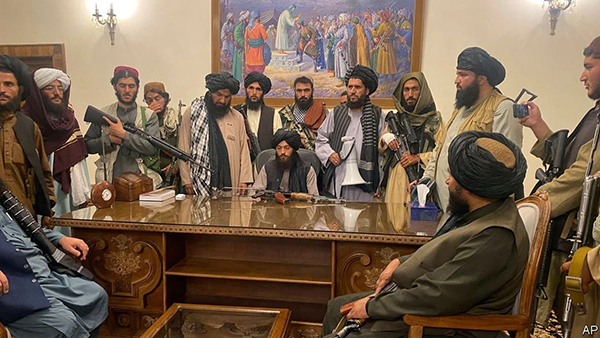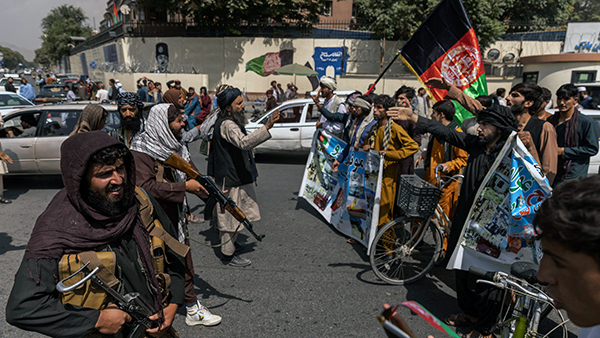
Inclusiveness, Women’s Rights Key to Recognition
While no one knows if Taliban have changed, it will find that Afghanistan has changed in the last 20 years. It is a young nation with a median age of 18-and-a-half years. More than two-thirds of the population is below 30, and this cohort has grown up in a conservative but open society; 60% of the population enjoys internet access. They, along with women and minorities, will resist a return to the Islamic Emirate of the 1990s.
Their first attempt at projecting themselves as urbane has not given them the desired results. The world saw through their statement that women would be allowed to work but within the framework of Islamic law. Still, they continue to balance their belief in strict, even regressive, religious laws and their desire for global legitimacy. The problem with the Taliban is that despite the acquired sophistication of the visible leadership, the ground-level fighters are the ones who will decide how the country will be run. Would the Taliban’s international leadership be willing to offer more concessions to the international community — like distancing from terror groups based in Afghanistan, amnesty to Afghans who supported the US, protection to working women, freedom of movement for foreign embassy officials — than the grassroots Taliban fighters are willing to tolerate?
Would the Taliban be willing to hold regular elections in the country as evidence of its belief in democracy? Will they allow ordinary Afghans to continue to shed conservatism and practice social freedoms they have come to enjoy in the last two decades? The Taliban is yet to give proof of the kind of governance it prefers — one that is, like in the past, known for its notorious cruelty or an authoritarian religious regime with a moderate face.
The Taliban are yet to present themselves as a cohesive group that can be given a second chance to retain power they have acquired so easily and by force.
Promises Broken
The dispensation in Kabul includes 30 Pashtuns, two Tajiks and one Uzbek, of whom 17 are UNSC proscribed terrorists. Its powerful interior minister is the pro-Pakistan Sirajuddin Haqqani, who carries a $10 million bounty on his head.
Moderates, involved in negotiations in Doha and those who were pro-Iran, were sidelined. Women were excluded. The Afghan government has made no effort to convince the global community of its intention to adhere to promises made in Doha.
Treatment of Women
Despite an attempt to show a liberal face, the Taliban have been enforcing a strict religious code on the public and violence against anyone who resists. The last time the Taliban were in power, women were not allowed to work. They had to cover their faces and be accompanied by a male relative outside their homes. Girls were not allowed to go to school. The Taliban had also banned TV, music, painting and photography, handed out brutal forms of punishment to those violating their Islamic code, and persecuted minorities.

There were reports of women being told to stay at home in Kabul, Helmand and Herat and not go to work or to school/college, contrary to the original announcement of Zabiullah Mujahid (spokesperson) on 16 August, while he overturned that statement on 24 August, saying women were asked to temporarily stay away.
The Haqqanis, Wardakis and Logari factions are vocal in asking women to work and study as they were doing pre-August 15. The Pashtun factions seem to be at cross-purpose on the subject at a time when jubilation over winning the war should have set aside differences.
The key differences that appear to be emerging are on policy with regard to women, education, narcotics, source of riches and China, despite its vicious violations of the rights of Uyghur Muslims, an anathema to an Islamic Emirate.
The Taliban initially issued statements that women would be part of the new cabinet. Within two days all female TV anchors were sacked and the women who tried to protest were publicly thrashed with belts.
Taliban spokesman Zakirullah Hashmi had to eat crow when he said, “A woman can’t be a minister… It is not necessary for women to be in the cabinet. They should give birth.”
Afghanistan’s history is littered with tales of resistance. Five women stood fearlessly with placards of protest. Their numbers were limited, but they were a symbol of resistance. Newspapers and television channels showed a Talib aiming his gun at a woman who had fearlessly flung aside her burqa’s mesh from her face. Now, Afghan women enjoy tremendous support among social media users.
While those associated with the past regime have been targeted, the Taliban have neither spared children nor women through their heavily armed moral police. Beauty parlours have been shut and billboards and ads with women’s faces have been blackened in the capital city.
When the Taliban took over Kabul in 1996, it had imposed an extreme version of Sharia law. While the harsh punishments appealed to some men seeking law and order, it was devastating for women: Schools for girls were closed and women were rarely permitted to leave the house. The group also banned nearly all forms of entertainment, from music and television to sports and kite-flying.
The American invasion brought a new constitution that treated men and women equally. Although women still faced discrimination, life was far better than under Taliban rule, with girls and boys able to attend school together. Many Afghans also got a taste of modern life, with access to the internet, Western films and a popular national cricket team.
While the group is “a very different kind of Taliban” from earlier decades, it remains to be seen if Afghanistan’s new rulers will allow women in government, cooperate with former enemies and respect basic freedoms.
The US and its allies said recognition of any Taliban-led government would depend on the Taliban’s willingness to create an inclusive discussion that includes women and minority groups.
Anti-Taliban Protests
Since seizing Kabul on 15 August, the Taliban presented a more moderate face to the world, saying they wanted peace, would not take revenge against old enemies and would respect the rights of women within the framework of Islamic law.
But flag-waving protesters took to the streets of Kabul and more Afghan cities on August 19 as popular opposition to the Taliban spread. Protests flared up in Jalalabad and a district of Paktia Province and eastern cities and several killed by the Taliban.
US Conditions
The Taliban are consolidating their hold on Kabul by identifying and eliminating those involved with the security set-up of the previous regime while trying to work out a face-saver transitional government in lieu of recognition from the west.
The United States, the European Union and others have cast doubt on such assurances, saying formal recognition of the new government – and the economic aid that would flow from that – is contingent on action.
German Foreign Minister Heiko Maas said that Germany was ready to resume a diplomatic presence in Kabul if the Taliban met certain conditions.
French Foreign Minister Jean-Yves Le Drian said that Paris had yet to see positive signals the group had changed.
The Biden administration had committed to at least $300 million in reconstruction assistance after the US withdrawal to “demonstrate our enduring support for the Afghan people.” And the Afghan people certainly need it. According to a 2019 World Bank study, 75% of the Afghan government budget is funded by international donors, with the US the largest by far.
The good news is that the Biden administration has begun to set out conditions for recognising the Taliban. Secretary of State Antony Blinken said that the US would recognize and work with a Taliban emirate in Afghanistan if it respected the rights of its citizens and did not harbour terrorists. The US Treasury Department has frozen all Afghan government assets in US banks.
But one never knows with the Biden administration. After all, it is still trying to negotiate the lifting of sanctions and return of frozen assets with another Islamic regime, in Iran, that shows as much respect for human rights — and as much hospitality to international terrorists — as the Taliban.
Pakistan Factor
All these inherent contradictions are confused with Pakistan’s interests in Afghanistan, which promise to make the formation of a government very difficult, leave alone its continuance. Pakistan is clearly focused on an inclusive government, concerned that the Pashtun versus others sentiment must not emerge, else its original concern, that of an independent Pakhtunistan, will cause it serious bother.
The Taliban today is also not a unified entity. Mullah Baradar is a co-founder of the Taliban and Mullah Omar was his brother-in-law. The Inter-Services Intelligence (ISI) took him into custody in 2010 to punish him for being in direct contact with President Hamid Karzai. Eight years in ISI custody is unlikely to have left him with happy memories. The Doha negotiators constitute the public face but the fighting has been done by local commanders on the ground. The Quetta shura is headed by a cleric, Mullah Haibatullah Akhundzada and two deputies, Mullah Yaqub, son of Mullah Omar who has been overseeing military operations in the south, and Sirajuddin Haqqani who heads the Haqqani network, operating in the east.
One of the most interesting parts of the history of modern Afghanistan is that it was the only country which formally objected to the creation of Pakistan when the British left India. It was their contention that the Durand Line, which divided Pashtun tribal areas and incorporated the eastern regions into Pakistan, was merely an artificial line arbitrarily drawn by the British. Pashtuns were the people who lived in the eastern slopes and foothills of the Hindu Kush mountain ranges up to the plains of the Indus. After independence, the Pashtuns dreamt of an independent Pakhtunistan. In the early years of the 21st century, the military of Pakistan sought to crush this dream by killing almost half a million Pashtuns and displacing over three million, all in the name of the myth that religion breeds brotherhood and unity.
Taliban was united only once in its history that is during the leadership of Mullah Omar. Subsequently, it was the ISI of Pakistan that maintained unity among the factions like the Haqqanis, Durranis and others.
There is an intricate relationship between Taliban and Pakistani state with the former having their bases and families in various parts of Pakistan. However, it is a fact that the Taliban don’t recognise the Durand Line, which is one of the existential issues for Pakistan’s Punjabi elite, both in the military as well as political spectrum.
The old headache of relationship between the Tehreek-e-Taliban (TTP), Pakistani Taliban and Afghan Taliban is already bothering the Pakistani governing elite. This is reflected in the recent release of TTP terrorists such as Maulana Faqir Mohammad, who is from Pakistan’s Khyber Pakhtunkhwa province. He is the former deputy chief of the TTP with reported ties to the al-Qaeda leadership.
Deobandi Extremism Funds Taliban
To understand their governance model, one must look at the Deoband school of Islam which started during 1866, as part of the revivalist movement that was sweeping British India. The Deobandi movement became the most popular school of Islamic thought among Pashtuns living on both sides of the Durand Line. Many prominent Pashtun community leaders established Deobandi seminaries in these areas. In other parts of British India, however, they faced competition from other Islamic schools, primarily Barelvi Islam, the most popular Islamic school in what is now Pakistan’s Punjab province. It was not surprising that during the Afghan jihad in the 1980s, Deobandi seminaries on both sides of the Durand Line, as many scholars have pointed out, were the prime target of Saudi funding and influence. Along with Pakistan and the United Arab Emirates (UAE), Saudi Arabia was one of the few countries that recognised the Taliban after they assumed power in 1996.

















